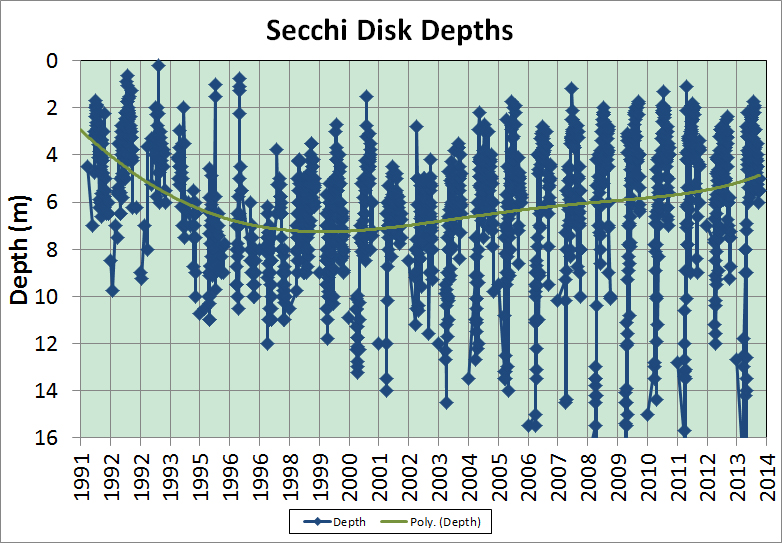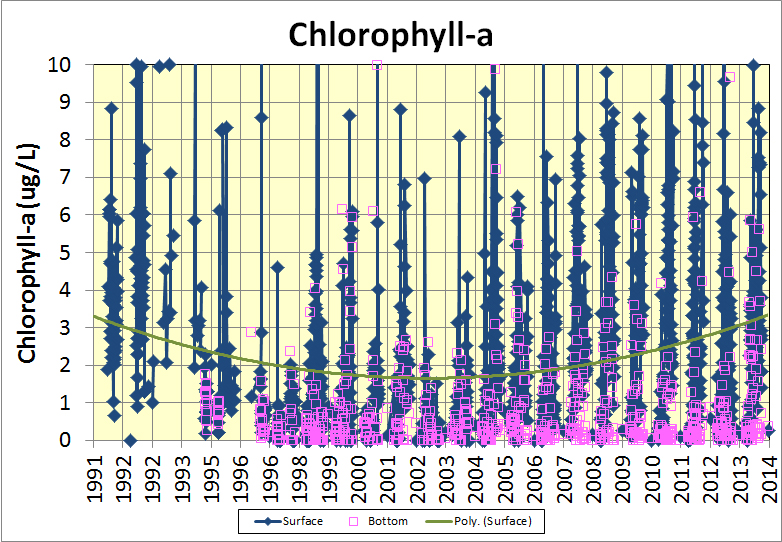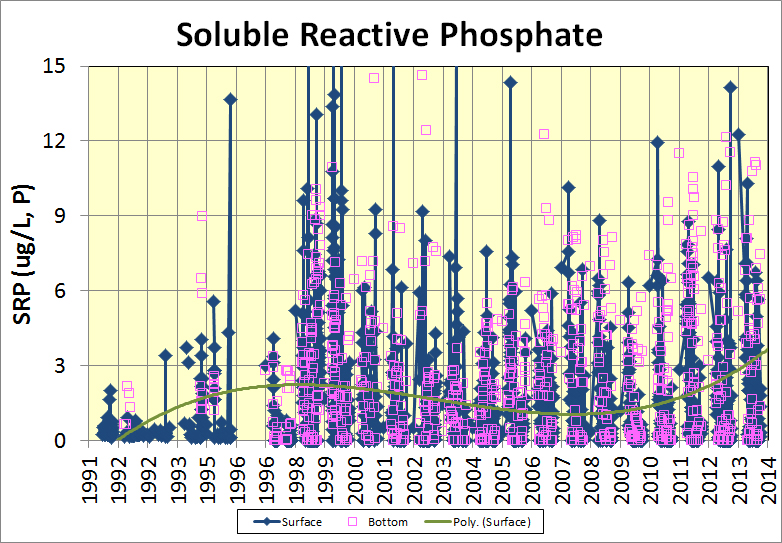Secchi Disc Depths: The
Secchi disc is a simple but robust method to measure water transparency (shown
left). The disc is attached to a rope and slowly lowered through the water until
it just disappears from view. This depth is noted. It is lowered some more,
then slowly raised until the disc is just observed. This depth is also noted.
The Secchi depth is the average of these two depths. 
The depth is proportional to water transparency and inversely proportional to water turbidity, but it is also influenced by cloudiness, position of the sun, roughness of the water, and observer bias. Plankton biomass and suspended mud particles are the main contributors to water turbidity. In Seneca Lake, the depth is primarily a function of plankton biomass.
In Seneca Lake, Secchi depths ranged from under 1 to over 12 meters during the 1990s and has expanded this range in the 2000s (see graph). Please note - the water surface is at the top edge of the plot and deeper depths (more transparent / less turbid water) extend vertically downward. The depths gradually increase from 1992 to 1997, rise slightly in 1998 through 2001, and finally return to deeper depths in 2002. Since 2002, secchi depths have gradually decreased, except for substaintially deeper depths in the early spring. Does this reflect a long-term trend in Plankton biomass?
Click here for a MS-Excel data table of Secchi
Disc Depths.
 Chlorophyll-a: Chlorophyll-a
is used by all phytoplankton (algae - microscopic plants in lakes) to harness
sunlight for photosynthesis. Its concentration reflects the total algal biomass
in the sample.
Chlorophyll-a: Chlorophyll-a
is used by all phytoplankton (algae - microscopic plants in lakes) to harness
sunlight for photosynthesis. Its concentration reflects the total algal biomass
in the sample.
In Seneca Lake, chlorophyll-a concentrations were high during the early part of the decade and steadily decreased over time to 1997, except for a reversal in the overall trend in 1998 through 2001. This variability parallels the Secchi disc depths (shown above), i.e., more plankton correspond to a shallower Secchi depth (and more turbid water).
The covariance suggests that the water clarity is related to algal biomass. Why has the plankton disappeared through the 1990's to 1998? One reason may be a lack of nutrients, especially the limiting nutrient phosphorus.
Sincwe 2002, chlorophyll concentrations have steadily increased. It still covaries with secchi disk depths. Perhaps nutrient loading has increased the amount of phsophates in the water, which in turn have been assimulated by the plankton, allowing for more chlorophyll in the water and shallower secchi depths since 2002. Nutrients enter the lake from a number of probably sources including effluent from wastewater treatment plants, effluent from individual homeowner septic and other onsite systems, and runoff from agricultural land.
 Phosphorus: Phosphorus and nitrogen limit
algal growth in lakes and ponds because there is never enough dissolved nutrients
available to synthesize amino acids, DNA and other critical cellular material.
Dissolved silica can limit diatom growth as well since silica is required to
make their frustules (shells). Phosphate (the ion group for dissolved phosphorus)
is typically more scarce than the other nutrients in freshwater systems, thus
its availability / concentration is directly proportional to the amount of algae
in lakes and ponds. This last statement is especially true in Seneca Lake.
Phosphorus: Phosphorus and nitrogen limit
algal growth in lakes and ponds because there is never enough dissolved nutrients
available to synthesize amino acids, DNA and other critical cellular material.
Dissolved silica can limit diatom growth as well since silica is required to
make their frustules (shells). Phosphate (the ion group for dissolved phosphorus)
is typically more scarce than the other nutrients in freshwater systems, thus
its availability / concentration is directly proportional to the amount of algae
in lakes and ponds. This last statement is especially true in Seneca Lake.
In Seneca Lake, phosphate concentrations range from 0.1 to 10
ppb (see plot). Phosphate concentrations are typically low, especially in the
early part of the decade, but rise sharply in 1998 and remain high in 1999.
Since 2000, phosphate values appear to decline again. The observed phosphate
trend, taken alone, suggest lower algal concentrations and deeper Secchi depths
in the early part of the decade, and significantly more plankton and shallow
Secchi depths in 1998 through 2001. HOWEVER, the Secchi depth and chlorophyll-a
data presented above contradict this first-order conclusion. Zebra mussels
may explain the apparent discrepancy.
Zebra
Mussels: The exotic bivalve was first detected in Seneca
Lake during the summer of 1992. It apparently made its way from Lake St. Clair
(Detroit area) where it was accidentally was introduced to North America by
ocean going ships. It is notorious for filter-feeding large volumes of plankton
each day. It also colonizes "new" territory quickly due to its planktonic
(free-floating) larval stage, prolific reproduction and minimal predation.
It quickly colonized Seneca Lake, and
was well established by 1995. Curiously, the introduction and establishment
of zebra mussel corresponds to the increase in Secchi depths and decrease in
algal concentrations. By 1996 and 1997 algal concentrations were at an all time
low, probably a result of overgrazing by an established population of zebra
mussels. The coincidence suggests that zebra mussels have had a profound impact
on the ecology of Seneca Lake, significantly decreasing algal concentrations
over the past decade. The result is a less turbid lake. For the first time in
a few decades, lake shore residents can see the lake floor at the end of their
dock, and tourists appreciate the "cleaner" water.
The anomaly in 1998 and 1999 deserves special notice. During 1998 and through 2001, algal concentrations increase, Secchi depths decrease and phosphate concentrations dramatically increase from previous years. What triggered the change? A number of possibilities exist including smaller number of zebra mussels, increased phosphorus loading from farms, perhaps related to an increase in hog farming over the past few years, larger than normal spring runoff in 1998, and/or increased recycling of the sequestered nutrients by the bacterial decomposition of dying zebra mussels. The first choice is unlikely because zebra mussel populations have not decreased over time based on, albeit incomplete, zebra mussel counts of surface sediment dredges. The hog farming impact is the next least likely of the four options because very few pig farms have been established in the last few years, especially within the Seneca Lake Watershed, and our preliminary hydrochemical data suggest that the chemical composition of runoff (streams) from these few farms is not much different than other streams in the watershed.
Clearly, stream flow during the spring of 1998 (the spring
of high lake levels) was usually high,
and high runoff washes in large amounts of dissolved phosphate. This anomaly
can explain the rise in phosphate concentrations at the start of the year but
can not explain the jump in phosphate concentrations during midsummer and the
large values in 1999. This summer jump in 1988 may be explained by bacterial
decomposition of dead zebra mussels because the process would return previously
sequestered nutrients to the water column. The recycling of dead zebra mussels
was not prevalent earlier in the decade because zebra mussels live for 4 to
10 years, and the earliest mussels are just now beginning to die in large numbers.
Thus, nutrients that were sequestered into living zebra mussel tissue in the
early part of the decade, are just now returning to the water column. 1998 and
1999 probably saw a significant amount of bacterial recycling because the lake
was unusually warmer than normal last summer (Ahnrsbrak, unpublished data),
and warmer water temperatures induce faster bacterial decomposition of dead
organic matter. Recent finds of significant quantities zebra mussel shells by
lake shore residents along the shoreline for the first time provide partial
support for this hypothesis. The decline in algal concentrations since 2001
and growing number of zebra mussels in bottom dredge samples suggest that zebra
mussels are on the rise, and water clarity should increase once again. Perhaps
the ecology of Seneca Lake will settle down to a new equilibrium level that
allows for the co-existance of zebra mussels within the nutrient cycle of the
lake.
The last decade has seen a decline in secchi depths and increase in chlorophyll concentrations. It suggests that even zebra and now quagga mussels can not keep Seneca Lake clean, and that nutrient loading from the watershed is indeed altering the clarity of the lake in the recent years. The early spring when the lake is still isothermal secchi depths have been significantly deeper than previous springs. Perhaps the mussels can effectively cleanse the water of algae in the early spring, as their filtering capacity can remove the existing algal populations. Algal populaions are limited in the early spring because algae are light limited in the early spring. The extra clear water has two probably impacts. (1) The scarce food resources limits mussel populations, and (2) the clear water allows sunlight to reachthe lake floor in deeper water. The deeper light penetrations, will increase the habitate for nearshore rooted vegetation (marcophytes) and may explain the increase in Eurasian milfoil populations in the past deacde. The minimal springtime algal populations only support a minimal mussel population. During the summer season, light no longer limits algal growth, and they fluorish. The existing mussel population however can not decimate the bloom of algae because their populations were limited by low spring algal counts.
A few last comments.
Acknowledgements: The following students made a significant contribution to this ongoing study...
Nadine Acquisto (WS'95), David Cohn (H'95), Mary Gibbons-Neff (WS'97), Keri Lesniak (WS'97), Andrea Pulver (WS'97), Jennifer McKnight (WS'97), Damian Herrick (H'97), Ethan Prout (H'97), Andrew Babaian (H'97), Theron Bond (H'97), Matthew Lamana (H'97), Matthew Nuzzo (H'97), John Fiori (H'97), Kathleen Maloney (WS'98), Robert Dedrick (H'98), Thomas Sardella (H'98), David Went (H'98), Jason Christensen (H'98), Jason Farnung (H'98), Nathan Kranes (H'98), Kathryn Hammontree (WS'99), Megan LeBoutillier (WS'99), Kevin Farr (H'99), Andrew Dominick (H'99), Miki Alroy (H'99), John Vandemoer (H'00), Jon Rumpf (H'00), MaryBeth Giancarlo (WS'00), Timothy Riley (H'01), Derith Hart (WS'01), N. Scott Alderman (H'01) , Lindsey Bowser (WS'02), Sandy Baldwin (WS'02), Margaret Etherington (WS'02), Meghan Zarnetske (WS'02), Andrew Dibble (H'02), Laura Calabrese (WS'02), Robert Stewart (H'03), Ted Wilson (H'03), Gail Reynolds (WS'03), Jennifer McDonald (WS'03), Emily LaDuca (WS'04), Andy Baker (H'04), Cathy Caiazza (WS'05), Ann Walker (WS’05), Barbara Beckingham (WS’05), Sarah Kostick (Smith, ’05), John Riina (H’05), Doug Wood (H’05), Kate Bush (WS’06), Clare Morgan (WS’06), Suzanne Opalka (WS’06), Ian West (H’06), Rachel Sukeforth (WS’07), Brittany Holler (WS’08), Christina Kinnevey (WS’09), Clancy Brown (WS’10), Kerry O‘Neill (WS’09), Rachael Dye (WS’10), Casey Franklin (WS’10), Samuel Georgian (H’10), Prabighya Basnet (WS’11), Katherine Hoering (WS’11), Andrea Rocchio (WS'11) .
Reports:
Presentations:
One purpose of this site is to provide Science-On-Seneca teachers a handy reference for the "Zebra Mussel Story" at Seneca Lake. Feel free to contact John D. Halfman, Professor of Limnology, Hydrogeology & Environmental Geology, Hobart and William Smith Colleges or look at his web site for information on Seneca Lake.
Last Updated on 1/8/2015
By John D. Halfman, Dept. of Geoscience,
Hobart & William Smith Colleges